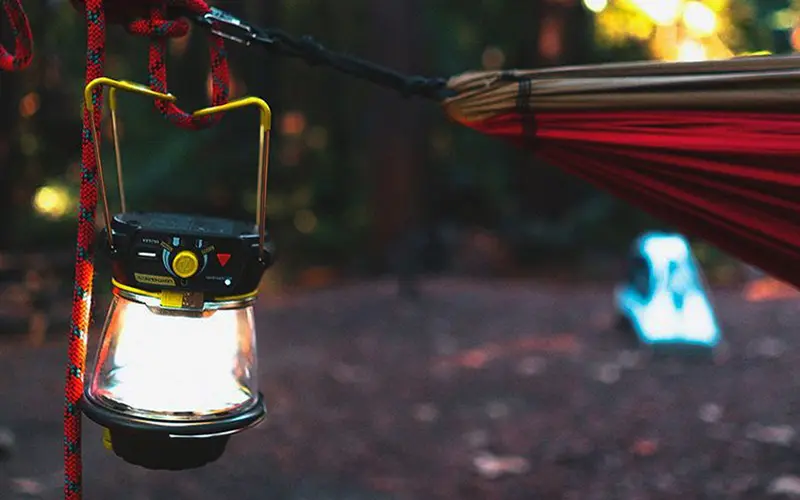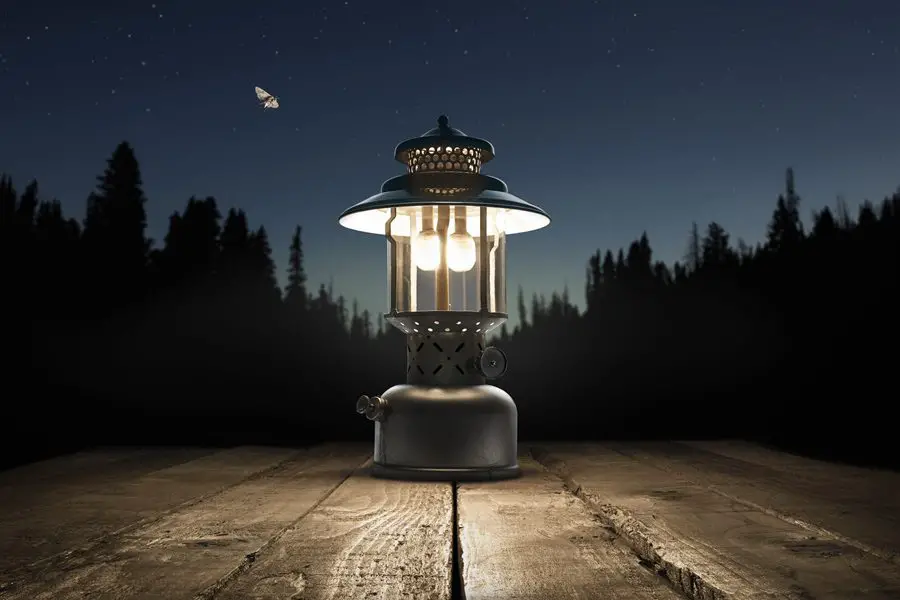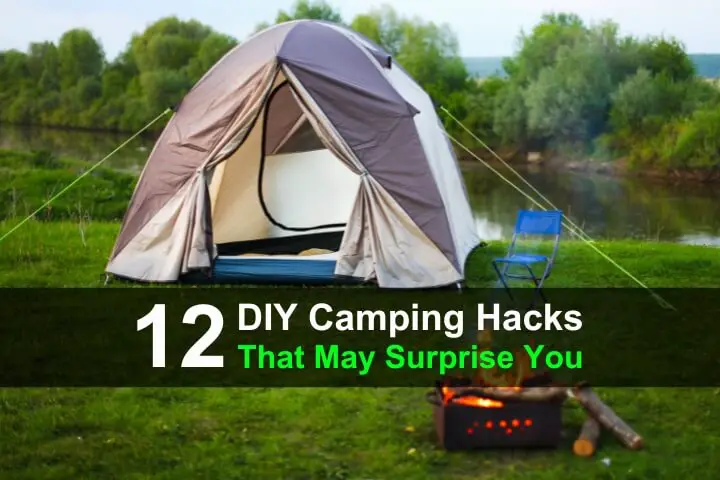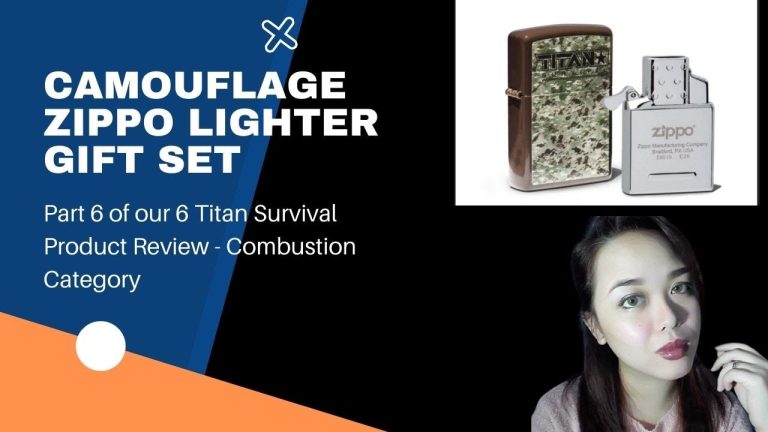SHTFPreparedness may collect a share of sales or other compensation from the links on this page.
Having a camping lantern will provide you with a reliable light source when you need it during your camping trip.
In some cases, you might arrive late, so you’ll need it to set up the camp, cook dinner, or enjoy a nighttime read.
We’ll highlight the key features and benefits you should look for when selecting the lantern that will suit your camping needs.
Best Camping Lanterns Reviewed
1. Coleman CPX 6 Camping Lantern
Coleman are the kings of the outdoors, and while we all know this, they continue to make that fact all the more prevalent with excellent products like this. The CPX lantern runs off of four D-size batteries but is also rechargeable.
It’s a great little unit that outputs a crazy amount of light without draining too much power. You’ll get 1,000 lumens of darkness-cutting bright light, which beats simple LED lighting every day of the week.
Coleman has a ton of different modes on this LED lantern, giving you a multitude of usage hours and brightness options. At its lowest setting, you could keep it on for a straight one hundred hours and illuminate small areas without worrying.
This makes the CPX a great tool to bring in from the outdoors after extinguishing the fire, and to keep a low light on near your sleeping bag for comfort.
There’s a difference between a lamp and a lantern, and this is a true lantern, giving you three hundred and sixty degrees of excellent light to brighten up campsites of roughly five hundred square feet or less.
The interior design near the light source isn’t blinding to look at directly, but it still provides
Pros
- Provides more power with less energy.
- Fully waterproof and impact-resistant
- Rechargeable for use
Con
Product Information
- Dimensions: 12” x 6” x 6””
- Weight: 3.0 lbs.
- Material: ABS plastic, rubber
- Lumens: 1,000
- Duration: 100 hours (low)
2. UST Duro LED Camping Lantern
- brightness: 1000 lumens of bright, clean light with high,…
- dimensions: 7.2” H x 3.75” W with a weight of 1.9lbs…
- versatility: Built-in, recessed hook on the lantern base for…
Our runner-up has a ton of durability, and that’s what first and foremost attracts users. No matter where you place it, this fully rubberized ABS plastic case will retain fairly good traction.
On top of that, it’s also water-resistant and impact-resistant for short drops (usually three feet or closer will be okay). So they made it durable beyond everything else, but what makes this one of the best LED lanterns is its longevity.
If you put it in strobe SOS mode, you’ll get fifteen straight days of use out of it. You’ll be able to get a full thirty days out of the lowest mode, though that is designed for single use.
There are four modes available for you to choose from, allowing you to illuminate your space as you see fit. With all these inexpensive, bright camping lanterns, there will inevitably be one or two issues that arise.
You’ll notice the battery housing is fairly flimsy, while the lens tends to hold onto dirt and dust far too well. UST may have missed the mark, but they still turned this into a user-friendly lantern with one feature that we have yet to see: a recess hook in the top.
Hang it where you want, or simply bring it with you after depositing the hook into its housing; it’s really your call. The only thing we would change about this 700-lumen lantern is to add a new lens to actually get more use out of that source, but it still does the job well enough.
Pros
- Includes an SOS mode for emergencies
- Water-resistant and impact-resistant case
- The recess hook stays on the unit for easy hanging.
Con
- Battery housing is fairly flimsy.
Product Information
- Dimensions: 3.5” x 3.5” x 7.2”
- Weight: 1.5 lbs.
- Material: ABS plastic, rubber
- Lumens: 700
- Duration: 30 days (low)
3. Coleman Dual Fuel Camping Lantern
- Durable lantern designed for camping and outdoor use
- Dual-Fuel technology allows the use of Coleman Liquid Fuel…
- All Season Strong technology ensures reliable operation in…
Coleman is unbeatable in a variety of ways, earning three spots on our list. Turn the power and reliability of fuel into a sustainable light source, allowing you to use butane or propane to light up your campsite.
This lantern ranks in the middle of the first two we reviewed in terms of lumens, offering 861 for maximum coverage over nearly everything around you. Full blast gives you seven hours of use.
The only drawback is the lack of a dimming indicator, which leaves you scrambling to refill the fuel. Since there isn’t really a gauge or indicator light (like you might find on some LED models), you have to guess and keep topping it off.
This can become somewhat frustrating over time, but if you wish to prolong the light life, you can turn it down to a low setting for a total of forty hours.
Coleman designed this for use in extremely low temperatures, so even if you’re looking at the single digits, this isn’t going to fail on you. With purely electrical lanterns, cold temperatures can interfere with operation.
Coleman also offers a three-year warranty on this lantern, and while it’s limited, it covers just about everything you can imagine running into from outdoor use.
Pros
- A three-year limited warranty has great coverage.
- Water-resistant and impact-resistant case
- The recess hook stays on the unit for easy hanging.
Con
- Cold temperatures can interfere with operations.
Product Information
- Dimensions: 1.9” x 6.9” x 7.3”
- Weight: 4.2 lbs.
- Material: aluminum, glass
- Lumens: 861 (high)
- Duration: 40 hours (low)
4. Coleman NorthStar Camping Lantern
The NorthStar is certainly a viable, compact solution to illuminate the campsite, but there’s a reason that it didn’t beat the dual fuel lantern. For one, it weighs 6.7 pounds and has a little heavier at 6.7 lbs. and features a lower runtime.
Nine hours on the lowest setting isn’t terrible, especially when you consider that it’s all off of a 16.4-ounce propane cylinder instead of a larger source.
The primary area where this device excels is its ability to provide enough power to illuminate the campsite. 1,500 lumens beats everything else on this list in terms of power, and we’re personally pretty pleased with the plastic two-fold case that it comes in.
Although the case isn’t particularly unique, it offers the ideal level of vibration resistance during transit and prevents the glass lens on this lantern from cracking or becoming damaged.
You’ll get a bail-style handle for hanging this up on a tree branch or off a tent stake (you can peg one of these into a tree to hang your lantern).
It earned the title of official lantern of the NPF (National Park Foundation) due to its versatility, durability, and ease of control. That stands for something, and Coleman earned their favor through superior engineering on this lantern.
Pros
- It comes in a durable, protective case.
- The engine has a long runtime on low volumes of fuel.
- Consistent in extreme heat and cold
Con
- At 6.7 lbs, it’s a little heavier.
Product Information
- Dimensions: 8.7” x 9.2” x 12.8”
- Weight: 6.7 lbs.
- Material: aluminum, glass
- Lumens: 1,500
- Duration: 9 hours (low)
5. AGPTEK Solar Camping Lantern
- 5 Charging Methods: Solar Powered, Crank Dynamo, Car…
- Green Power: Hand Crank Dynamo Solar 36 LED Lantern Outdoor…
- Low Energy Consumption: Built in the Polysilicon solar…
You can’t mention the best solar camping lanterns without bringing the AGPTEK into play. Apart from its obvious low-price lovability, this thing is phenomenal and has a ton of features that make it impossible to ignore.
You get a durable ABS plastic and steel frame, and despite having so much hardware on the inside, you’re only packing a little under two pounds in total. Now the hardware isn’t in lumens; you only get 240, reaching about ten feet in each direction.
If you’re wondering what we’re talking about, there are five ways that you can change this: USB, car charger, batteries, solar, and a hand crank if you aren’t able to access any of those in an emergency situation.
The hand crank gives you a low amount of power, but it’s better than sitting in the dark. Between the versatility and the price, AGPTEK is a truly great camping lantern, but there are some issues with it.
Charging takes a while. If you want to maximize this, you’ll need rechargeable batteries with more power since you don’t have much internal power.
The only other complaint is the cheap feeling of the lens; it’s plastic and scuffs easily, and while we think the manufacturer assumed the steel cage would keep it protected, it doesn’t.
You get what you pay for, and while this is a high-functioning lantern, it’s more fragile than most.
Pros
- Recharge extremely quickly.
- Five ways to charge and use
- Low power consumption
Con
Product Information
- Dimensions: 5.5” x 4.5” x 10.5”
- Weight: 1.8 lbs.
- Material: steel, ABS plastic
- Lumens: 240
- Duration: infinite through multiple charge methods
Things to Consider Before Buying

1. Size
Is it stored in the SUV’s trunk? Is it kept in the rear of your 55-liter camping backpack?
Either way, you’ll need to get a compact lantern to save as much space as possible. Most lanterns come with about a 12” height and 6” width, which is fairly compact and effective.
Be warned that this doesn’t include the size of an external butane or propane canister on gas-powered models and sometimes doesn’t include the bail-style handle on the top.
If possible, detach the handle during transit and store it with other items.
2. Brightness
Lumens, a unit of measurement for brightness, roughly correspond to a lightbulb’s wattage.
For instance, a 600-lumen light is going to look just like a 60-watt light bulb. The more lumens, the more powerful your light source is, but there’s something else to consider here.
If you have a tactical flashlight, 600 lumens in it isn’t going to be the same as the lumens in your lantern, and I’ll explain why.
Lanterns focus on a 360-degree output, whereas flashlights have miniature mirrors and have about a 45-degree output, maximizing the focus.
As we discovered during reviews and investigation, one of the biggest mistakes users make is comparing their flashlights and lanterns together without understanding how to view the output.
3. Light Duration
Lumen power, the power source, and your light mode settings will all affect how long your light will last.
Many LED lanterns have a long life on low or SOS mode, sometimes even offering a light source for up to thirty straight days.
Keep in mind that this is usually 8–10 lumens of power, which is barely enough for a personal light source.
While gas lanterns have a significantly shorter light duration after a single use, you can refill them with new canisters in less than a minute to extend the overall light duration.
4. Weight
We often discuss the importance of every ounce when camping.
If you’re overpacking your bag, you’re going to be fatigued and exhausted by the time you reach the campsite, negating all the hiking, fishing, and setting up that you were going to do.
The weight of camping lanterns matters because they’re either going to be around two pounds or all the way up to nine pounds (more than a gallon of milk).
LED and solar lanterns are usually lightweight, while gas-powered lanterns are often heavier.
Lanterns vs. Headlights
Similar to a flashlight, a camping headlamp projects light in one direction at an angle of 45 to 110 degrees.
Whether you’re referring to literal headlights that you wear on your head or a headlamp that directs the brightness in one direction, they’re focusing their power forward.
This provides better illumination for the path ahead, but it doesn’t cover 360 degrees like a lantern does. Wearable headlights are also better for personal use, whereas a lantern is suitable for a party of two or more.
A lantern provides a full circle of light to monitor your surroundings and prevent you from becoming separated from your group.
Lanterns are better for campsite use, while headlights might be better for a solo hike when the sun’s going down. Generally speaking, lanterns are more durable and last longer than headlights.
Types of Camping Lanterns
1. LED
LED camping lanterns are all electronic; to charge, they require batteries, car chargers, or a USB charge cable and a reliable power source.
The good thing about an LED lantern is that you’re eliminating the risk of causing a fire in your tent if you kick it over in the middle of the night.
They come with durable, heat-resistant lenses and steel cages on the outside, preventing the heat from igniting even the driest of brushes. You could lay these on their side in dry grass and nothing would happen.
Family campers generally prefer these for the overall safety of their loved ones, but they also offer brightness benefits.
Generally speaking, most LED lanterns of the same size and dimensions as their gas-powered counterparts have an average of 300 more lumens of power. They’re a viable option with safety features in mind.
2. Gas Powered
The good old way of doing things is not exactly the best way to be environmentally conscious. Gas-powered lanterns usually use a 16.4-ounce butane or propane canister and burn this fuel to light up the lantern.
While we didn’t list flame lanterns, they do exist and offer a much higher risk of your tent or campsite catching on fire from mishandling.
But the upside to gas-powered lanterns is that you don’t have to rely on a USB charger or car charger to keep the power rolling.
Even though gas-powered lanterns usually run for 10–40 hours, whereas LED lanterns can run for weeks, that energy source will eventually run out.
With gas, you can repeatedly pop in butane tanks as needed and continue to light up the night.
3. Solar
You’ve witnessed the solar trend sweeping across all power source types, and now it’s extending to lanterns. To clarify, there have been solar lanterns for well over a decade now, but they weren’t very effective.
Nowadays, you can get your entire power source from solar energy, so long as you have an ample spot to leave your lantern.
Even with solar lanterns, they usually offer an alternative method of power. Our solar lantern by APGTEK uses five different electronic power sources.
At the very least, they’re versatile, but they also use clean energy to power your campsite, eliminating any carbon footprint you would have from disposing of butane canisters on gas-powered lanterns.
The downside is that you will see lower lumens in most solar models, and by a significant amount—50–60% lower than standard LED lanterns. They’re inexpensive, but in high-volume conditions, they can be ineffective.
Maintenance and Cleaning
Maintaining your camping lantern is a fairly straightforward task. You need to clean the entire lantern, but especially the lens.
That will cover the majority of your maintenance, but we’d like to discuss a few tips and things to look out for to help you.
- If your lantern has a handle, use WD-40 from time to time to keep it from squeaking and scraping against the top of the lantern cap.
- Apply a rubber-restoring spray to cracks in rubberized stands to prevent further splitting and replacement. These are relatively cheap to pick up.
- Use a polish or wax on the steel cage surrounding the lens, giving it a little more illumination and keeping it looking fresh out of the box.
Even the best camping lights get pretty filthy after light use, and we recommend cleaning them after every single camping trip.
When you don’t clean your lantern (at least the lens) frequently, it impedes your visibility. If you already have low lumens to start with, then this is going to be highly noticeable.
For plastic lenses, the best thing we could offer is to grab a headlight restoration kit and use it on the lens after cleaning. It removes spotting, fogginess, and an overall hazy look that can often happen to your lens.
One kit, even a cheap one, will get the job done and last you for years since you’re using a tiny amount of the product. You only need to use restoration kits in between regular cleanings.
Wrap-Up
No matter which lantern you choose, go with one that’s specifically fit for your needs.
Everyone camps and spends their time differently, so you don’t want to rely solely on user recommendations.
Go with what provides the most value for you, and, of course, the highest quality lantern you can possibly get for your budget.

















